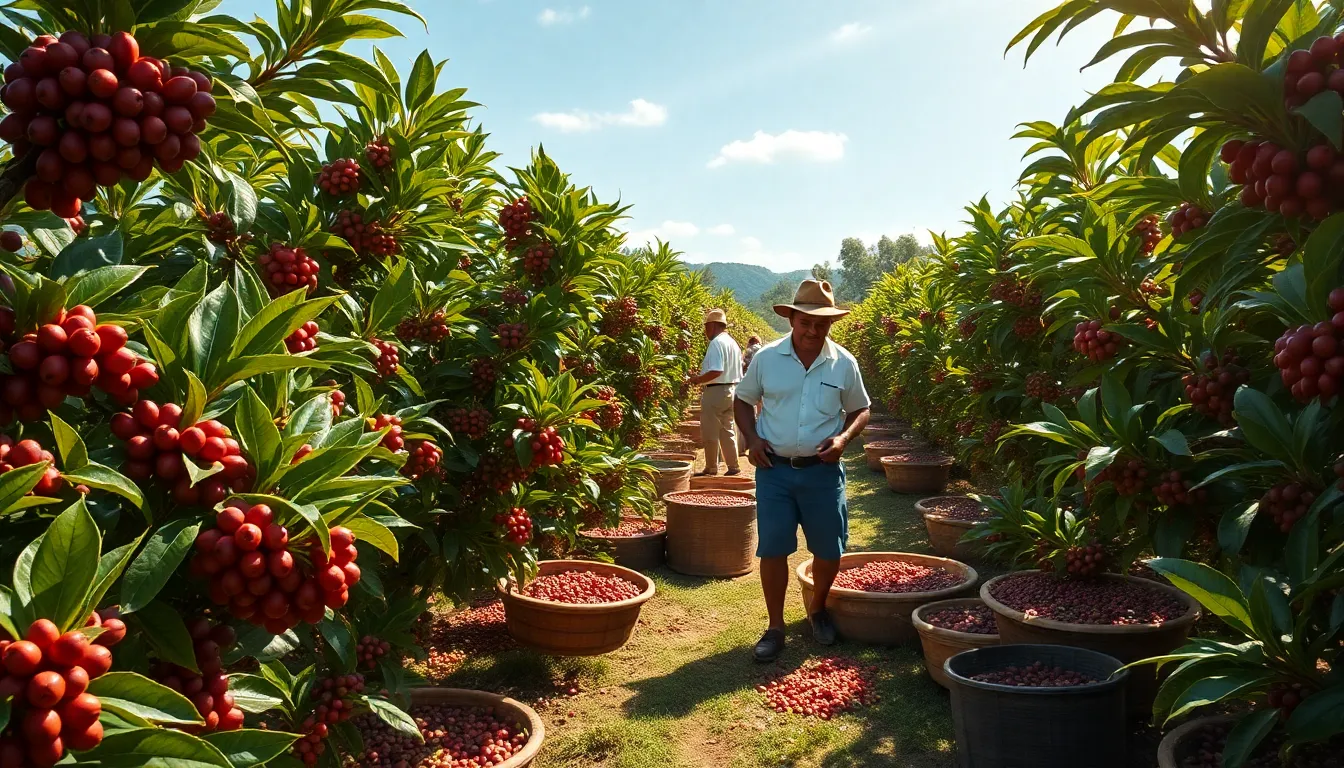Coffee lovers unite! The world of international coffee is a delightful adventure waiting to be savored. From the rich, bold brews of Colombia to the delicate, floral notes of Ethiopian beans, each cup tells a story that transcends borders. It’s not just a beverage; it’s a global experience that can transport taste buds to far-off lands without ever leaving the comfort of your favorite café.
Imagine sipping a perfectly brewed espresso while daydreaming of Italian piazzas or indulging in a creamy Vietnamese iced coffee that makes the tropical heat feel like a warm hug. Coffee isn’t just about caffeine; it’s about culture, connection, and the joy of sharing a moment with friends or even a good book. So grab your mug and prepare to explore the fascinating world of international coffee, where every sip is an invitation to travel.
Table of Contents
ToggleOverview of International Coffee
International coffee encompasses a vast array of flavors, aromas, and traditions. Coffee beans originate from numerous regions, each contributing distinct characteristics. Colombia, recognized for its smooth, rich brews, attracts coffee lovers worldwide. Ethiopian coffee, known for its intriguing floral notes, provides a stark contrast with unique tasting experiences.
Varying climate conditions influence the flavor profiles of coffee. High altitudes enhance acidity, while soil composition adds depth. Countries like Brazil dominate coffee production, exporting billions of beans annually. Vietnam follows closely, specializing in robusta beans that contribute to strong, earthy coffees.
Cultural practices surrounding coffee rituals differ significantly. In Italy, espresso is an integral part of daily life, served swiftly at cafes. Turkey highlights its coffee preparation method, brewing finely ground beans with water and sugar, creating strong, dense drinks. Meanwhile, Scandinavian countries focus on sustainability and quality, emphasizing lighter roasts that showcase the bean’s origin.
Varieties of coffee beverages reflect global preferences. While lattes and cappuccinos reign in Western coffee shops, traditional drinks like chai and Turkish coffee maintain strong followings. Specialty coffee shops promote single-origin brews that celebrate distinct regional qualities.
Sustainability movements increasingly influence international coffee production. Fair trade practices ensure that farmers receive fair compensation, promoting ethical consumption. Consequently, consumers become more aware of sourcing practices, driving demand for responsibly sourced beans.
Travelers exploring coffee cultures gain insight into local traditions and flavors. Tasting unique brews enhances appreciation and connects individuals across cultures. Expanding on this experience can foster a deeper understanding of coffee’s role in societies around the globe.
Origin and History

International coffee has deep roots in various cultures, with its cultivation spread across many parts of the globe. Each country contributes distinct flavors and traditions to the coffee experience.
Coffee Cultivation Countries
Brazil stands as the largest coffee producer, known for its diverse bean varieties and robust flavor profiles. Colombia ranks second, celebrated for smooth Arabica beans that appeal to many palates. Vietnam specializes in Robusta beans, which add bitterness and body to blends. Ethiopia, often called the birthplace of coffee, offers unique and complex flavor profiles with its heirloom varieties. Other notable growing regions include Guatemala, Costa Rica, and Honduras, each providing distinctive coffee experiences shaped by local climates and cultivation methods.
Historical Significance of Coffee Trade
Coffee’s journey began in the 15th century when it gained popularity in Yemen. Trade routes extended to Europe by the 17th century, fueling coffeehouse culture in places like London and Paris. These establishments became social hubs, fostering intellectual discussions and artistic movements. The transatlantic trade expanded in the 18th century, establishing coffee plantations in the Caribbean and South America. Each of these historical phases contributed to coffee’s global prominence, linking countries and cultures through trade and enjoyment.
Types of International Coffee
International coffee showcases a rich variety that captivates flavor enthusiasts. Different factors contribute to these unique profiles, reflecting local traditions and growing conditions.
Arabica vs. Robusta
Arabica beans dominate global coffee production, comprising about 60-70% of all coffee sold. Known for their smooth, mild flavor, Arabica beans thrive in higher altitudes under specific climates. Robusta beans, on the other hand, contain more caffeine and a bolder taste. They represent about 30-40% of global production and grow at lower elevations. Arabica’s sweetness contrasts with Robusta’s earthier notes, appealing to diverse palates. Coffee lovers often choose blends that include both for a balanced experience.
Specialty Coffee Varieties
Specialty coffee varieties gain attention for their distinct qualities and meticulous cultivation. These beans often undergo strict grading systems, requiring a score of 80 or higher by certified tasters. Among popular varieties, Geisha stands out for its floral notes and rarity, often fetching high prices. Bourbon, another sought-after type, offers rich flavors and complexity. These specialty coffees often originate from specific regions, showcasing unique terroirs. They encourage consumers to appreciate the nuances of coffee beyond traditional blends. Specialty coffee shops frequently introduce this variety, enhancing consumer knowledge and experience.
Coffee Brewing Methods Worldwide
Exploring coffee brewing methods reveals a wealth of traditions. Each technique captures distinct flavors and cultural practices.
Espresso and Italian Techniques
Espresso serves as the foundation for Italian coffee culture. A finely ground coffee is compacted and brewed, yielding a concentrated shot. This method emphasizes flavor and aroma, making it a favorite for many. Italians often enjoy espresso straight or with milk, leading to popular drinks like cappuccino and macchiato. The frothing technique for milk creates creamy textures, enhancing the experience. Traditional machines, like those found in cafes, reflect craftsmanship and expertise. Furthermore, imperative roles include barista training, ensuring each cup served meets high standards.
French Press and Nordic Practices
French press brewing offers a different flavor profile. It enhances body and richness by steeping coarsely ground coffee in hot water. Timed brewing allows for a fuller extraction, yielding a robust cup. Nordic countries embrace this method, focusing on light roasts that highlight delicate flavors. Recent trends showcase a rise in single-origin beans, sourced ethically for maximum transparency. Additionally, coffee served in these regions often emphasizes sustainability. Practices include sourcing from local roasters and promoting eco-friendly packaging. Thus, the culture of coffee in Nordic countries reflects a balance of quality and environmental consciousness.
Cultural Impact of Coffee
Coffee transcends mere consumption; it embodies connection and cultural richness. Various practices surrounding coffee shape social interactions across the globe.
Coffeehouses as Social Hubs
Coffeehouses serve as community meeting points, fostering conversation and creativity. These social spaces, like Italy’s historic cafés, often expand beyond coffee into the realm of culture. Patrons gather to exchange ideas, reflect on art, and engage in intellectual discussions. Public squares in Vienna feature coffeehouses, renowned for their unique ambiance and rich history. Across the Middle East, coffeehouses offer relaxed environments for socializing, where traditional music and games complement coffee drinking. The popularity of these establishments highlights coffee’s role in strengthening social bonds.
Coffee in Religious and Cultural Rituals
Religious and cultural rituals frequently incorporate coffee, illustrating its significance. In Ethiopia, the coffee ceremony symbolizes hospitality and community, bringing together family and friends. Rituals involve roasting beans, grinding them, and brewing in a special pot called a jebena. Similarly, in Turkey, coffee occupies a prominent role during weddings and special occasions. It reflects a gesture of courtesy, where offering coffee to guests signifies respect and friendship. Many cultures honor coffee in daily practices, emphasizing its spiritual and communal importance.
Exploring international coffee opens a door to a world rich in culture and flavor. Each cup tells a story shaped by geography and tradition. From the vibrant coffee ceremonies of Ethiopia to the bustling espresso bars of Italy, coffee serves as a bridge connecting people across continents.
As coffee lovers delve into different brewing methods and unique bean varieties, they not only savor the taste but also participate in a global community. Embracing the diversity of international coffee enriches the experience, inviting individuals to appreciate not just the drink but the cultural significance behind it. Whether enjoyed alone or shared with friends, each sip is an invitation to travel the world one cup at a time.





